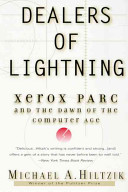

The book delves into the origins of Silicon Valley, exploring the cultural, social, and technological factors that contributed to its emergence as a global technology hub. It highlights key figures, such as William Shockley, who played a critical role in the development of semiconductor technology. The narrative illustrates how a combination of academic research, entrepreneurial spirit, and a unique geographical concentration of talent fostered an environment ripe for innovation. The author discusses the significance of institutions like Stanford University and the role of government funding in shaping the region's technological landscape. This idea emphasizes the importance of collaboration and the synergy between academia and industry in driving technological progress.
Continue readingOne of the central themes of 'Dealers of Lightning' is the idea that innovation often arises from collaboration rather than isolated efforts. The book details the interactions between various engineers, scientists, and entrepreneurs who worked together to develop groundbreaking technologies. It illustrates how diverse teams, with varying expertise and perspectives, can lead to more creative solutions. The author uses case studies of companies and projects that exemplified this collaborative spirit, demonstrating how cross-pollination of ideas can result in significant advancements. This idea serves as a reminder that fostering a culture of teamwork and open communication is essential for driving innovation in any field.
Continue readingThe narrative emphasizes that risk-taking and failure are integral to the innovation process. The book recounts stories of inventors and entrepreneurs who faced numerous setbacks before achieving success. This idea challenges the common perception that successful innovators are those who avoid failure. Instead, it posits that learning from failures and being willing to take risks are vital components of the creative process. The author argues that a healthy attitude towards failure can encourage more experimentation and ultimately lead to more significant breakthroughs. This perspective is crucial for anyone involved in technology or product development, as it encourages a mindset that embraces challenges rather than shies away from them.
Continue readingThe book highlights how individual personalities and leadership styles can influence the trajectory of technological innovation. It profiles key figures in the tech industry, examining how their unique traits and approaches shaped the companies they led and the technologies they developed. The author discusses the importance of visionaries who can inspire teams and drive projects forward, as well as the impact of less charismatic but equally important contributors. This idea underscores the notion that innovation is not just about technology but also about the people behind it. Understanding the dynamics of team interactions and the influence of leadership can provide valuable insights for anyone looking to foster innovation within their organization.
Continue readingThe book tracks the evolution of technology from the early days of computing to the rise of the internet and beyond. It discusses how market dynamics, consumer needs, and technological advancements are interrelated. The author illustrates how understanding market demands can drive innovation, leading to the development of products that meet the needs of consumers. This idea emphasizes the importance of staying attuned to market trends and being adaptable in a rapidly changing technological landscape. It serves as a reminder for entrepreneurs and product developers to prioritize user feedback and market research in their innovation processes.
Continue readingThe author explores the role of government and policy in shaping the technology landscape. The book discusses how government funding, regulations, and support for research initiatives have historically influenced technological development. It examines the relationship between public policy and private enterprise, highlighting instances where government intervention has spurred innovation or, conversely, stifled it. This idea points to the importance of understanding the broader political and economic context in which technology operates. For entrepreneurs and technologists, being aware of policy implications can help navigate challenges and leverage opportunities for growth.
Continue readingIn the concluding sections, the book speculates on the future of innovation, considering emerging technologies and their potential impact on society. The author discusses trends such as artificial intelligence, biotechnology, and the internet of things, contemplating how these advancements could reshape industries and everyday life. This idea encourages readers to think critically about the ethical implications of technological progress and the responsibilities of innovators. It serves as a call to action for current and future leaders in technology to approach innovation with a sense of purpose and social responsibility, ensuring that advancements benefit society as a whole.
Continue reading